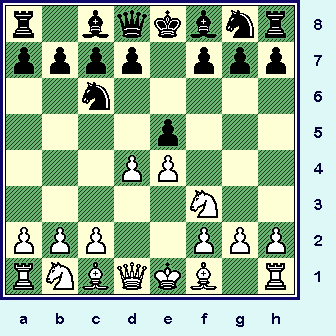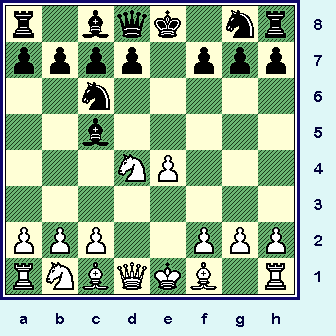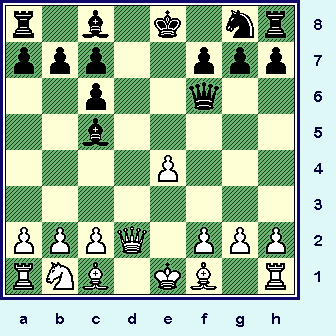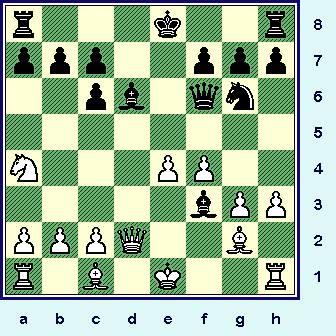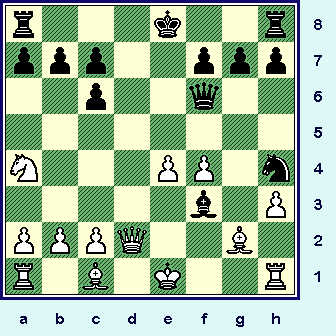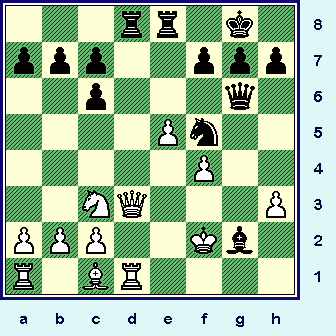All
the |
(Navigation bar
directly below.)
*******
© A.J. Goldsby, 2015.
(All rights reserved.)
****************
Click HERE
to see my
Chess Items.
****************
****************
Buy a book
from Amazon.com
(And help me out as well!)
****************
Click HERE
...
to see a list of the businesses that help to sponsor all of
my chess efforts.
Opening Trap - Scotch Game (#01)
A cool little opening trap ... and an interesting miniature as well.
Background information: I could not find out much, the Internet was my main source of information; although I remember a piece on Tomashevsky from a chess magazine.
The first player here is 19 years old and is an IM, the second player is a GM, and is 18 years old. (Both parties are still relatively young and have a great deal of chess talent!)
*************************************
NOTE: While I classified this contest as an opening trap, it is also a fine miniature as well.
Click HERE to see an explanation of the symbols that I utilize when annotating a chess game.
Click here to go to another server, and search for this game in a replayable format.
IM
Boris Savchenko (2569) -
GM Evgeny Tomashevsky
(2586)
[C45]
The Russian "Under-aged-20"
Championships (U20ch-RUS)
Cheboksary, RUS; (R#4) / 05,03,2006.
[A.J.G.]
|
|
**********************************************************************************************
As I write this, the latest issue of TWIC (#591) is only a day old. (March 07, 2006. - Ed.)
As part of my preparations for my "Game of The Month" column, I will go over dozens of games in the latest issue of "The Week In Chess." (Which you can download in your favorite format from the LCC.)
When I played over this game, I knew that I had to {briefly?} annotate it ... and place it on my website, (as an opening trap). Most of the time, it is lower-rated players that get caught in these things ... this time White is a player rated close to 2600!!!
**********************************************************************************************
1.e4 e5; 2.Nf3 Nc6; 3.d4!?, {Diagram
below.}
The Scotch Game.
|
|
r1bqkbnr/pppp1ppp/2n5/4p3/3PP3/5N2/PPP2PPP/RNBQKB1R b
Most class players have seen this, that is if you are around chess long enough.
I clearly remember playing at school when I was very young. When a buddy played this line, I did not know what it was - so I went home and looked it up.
I asked an older fellow at chess club about this line. He told me that it was a "questionable opening," and that ... "masters don't play it." My response was, "Why not?"
(Editor's note: I have always felt that the Scotch was a perfectly legitimate opening. And while, as a master, I must admit that this break may not put enough pressure on Black ... it is still a reasonable enough way to begin a chess game.)
For many years, you were lucky if the latest issue of the Informant contained even one good game in this line. Today, in the wake of Garry Kasparov's use of this hoary system, all that has changed.
[See MCO-14, page # 101 for more details, and a current survey of nearly all the commonly played variations.]
Of course 3.Bb5 is the Ruy Lopez, it is a time-honored opening and has been played by many World Champions.
3...exd4; 4.Nxd4,
The most commonly played move, although other options are tried on occasion.
[ After the following moves:
4.c3!? dxc3;
5.Nxc3, "~"
("comp") we reach the Scotch Gambit.
(It is also referred to by some as "The Goring Gambit.")
]
4...Bc5; ('!?') {Diagram below.}
The older, "Classical" response, and one of the first systems that I learned as a mere child.
|
|
r1bqk1nr/pppp1ppp/2n5/2b5/3NP3/8/PPP2PPP/RNBQKB1R w
This is a very old and well known position some of the examples in the database go back nearly 200 years.
[See also the volume, "The Oxford Encyclopedia
of Chess Games," Volume #1,
1485-1866.
Edited by IM D. Levy and Kevin O'Connell. (First published in 1981.)]
[ For an overview of the lines that begin with the moves of:
4...Nf6!?;
5.Nc3, The simplest reply.
*** *** *** *** *** *** *** *** *** *** *** *** *** *** *** *** *** *** *** ***
( For the continuation of: 5.Nxc6!? bxc6;
6.e5!? Qe7; 7.Qe2 Nd5;
8.c4 Ba6; "~" see the contest:
GM Garry Kasparov (2770) - GM Anatoly Karpov (2730);
ICT / Masters (1-0)
Tilburg, NED; (R #14) / 1991.
{White won an incredible game in just under 45 moves, and it is
annotated in Informant # 53 by Kasparov himself.}
See also the excellent book:
"Winning With The Scotch," by IM Gary Lane. )
*** *** *** *** *** *** *** *** *** *** *** *** *** *** *** *** *** *** *** ***
5...Bb4; 6.Nxc6
bxc6; 7.Bd3 d5; 8.exd5, "+/="
{Diag?}
please see MCO-14, page # 102. (Columns 1-6, and all notes.)
One of the best GM examples of this whole line would have to be:
A. Shirov (2710) -
A. Karpov (2715); /
ICT / Moscow, RUS; 1992.
{A finely played draw in under sixty moves, this whole contest was
annotated in Informant # 56.}
*********************************************************************************************
( After the moves: </=
8.e5? Ng4!; 9.0-0,
(Or 9.h3 Nxe5;
10.0-0 Nxd3; "/+"
and Black is already better.)
9...Bc5!?; (tempo loss)
( Probably best is:
>/= 9...0-0; "~")
10.h3?, (Definitely not good.)
( A lot better is:
>/= 10.Bf4, "+/=" when White may yet come
out of the opening with the advantage. )
10...Nxe5; 11.Re1 Qf6;
12.Qe2?! 0-0!; 13.Qxe5? Qxf2+;
14.Kh1 Bxh3!; 15.gxh3 Qf3+;
16.Kh2 Bd6; "-/+" {Diag?}
White loses the Queen.
See the excellent book: "Winning Chess Traps,"
by the one and only
Irving Chernev. (Trap # 65.)
Originally printed in 1946 by 'Chess Review' and reprinted
many times since then. )
]
5.Nxc6!?, (Possibly dubious?)
Many openings books condemn this as bad ... the reason being is that after Black's response here, the first party has real problems in effectively protecting the sensitive and oft-attacked f2 point.
[ One of the (modern) main lines is reached after the following moves:
>/= 5.Be3
Qf6; 6.c3 Nge7; 7.Bc4
Ne5; 8.Be2 Qg6; 9.0-0
d6; "~"
(Close to "=" here.) but Black has no real problems in this
position.
(Although White has won some
very nice games from the current
board set-up.)
[ See MCO-14, page # 107; column # 13, and all related notes. ]
A good - relatively recent - example from this position would be:
M. Narciso Dublan (2476) - E. Janev (2460); [C45] /
ICT, Masters (Open)
Barbera del Valles, ESP;
(Rnd. #7) /
10,07,2005. (1-0, in 42 moves.)
]
5...Qf6!;
A nice zwischenzug or ... "in-between move."
(Because of the threat of mate on f2, White cannot save the Knight.)
6.Qd2!?, hmmm
Several books give this as forced, but maybe Qf3 was White's safest and most reliable move here.
[ (>/=) 6.Qf3 dxc6; 7.Nc3, "=" ]
6...dxc6!; {Diagram below.}
Just about every beginner who has ever pushed a Pawn, has heard the advice, "ALWAYS capture towards the middle of the board!"
(A good rule of thumb.)
|
|
r1b1k1nr/ppp2ppp/2p2q2/2b5/4P3/8/PPPQ1PPP/RNB1KB1R w
Here Black violates this useful piece of advice, but with good reason.
# 1.) It avoids a loss of time.
# 2.) The Black QB is freed for immediate duty.
# 3.) The d-file is opened, which is especially useful for Black, as the
White Queen is somewhat exposed on the d2-square.
[ After the moves: (</=) 6...Qxc6!?;
7.Nc3 Nf6; 8.Bd3 0-0; 9.0-0, "~"
White is experiencing no real difficulties, and may even be just a
little better here. ]
7.Nc3 Ne7; 8.Na4?!, ('?')
A truly ludicrous waste of time. (White was hoping to win the "minor exchange" here.)
[ >/= 8.Qf4, "=" ]
8...Bd6!; (Maybe - '!!')
White was probably surprised by this, and may have thought that 8...Bb6 was virtually forced here.
9.f4?!,
(Threatening a Pawn fork.)
This looks like it scares up some nasty threats, but all White really does is waste time and weaken more squares.
[ (>/=) 9.Qg5 Qxg5; 10.Bxg5, "=" ]
9...Ng6!; (Looks bad ... at first.)
Black does not panic, but calmly gives the Bishop a possible retreat to f8, and also allows his
Queen the use of the e7-square.
Not only this, Black exerts extra force on the f4-square, and forces White to protect it with g3 ... which in turn weakens all of the light squares on the Kingside.
10.g3[],
White has no choice, the seemingly winning Pawn fork fails to a nice tactic, (see the note just below).
[ </= 10.e5? Bxe5!; 11.fxe5 Qh4+; 12.Qf2 Qxa4; "/+" (Maybe "-/+") ]
10...Bg4; ('!?') hmmm
This is very provocative ... and tempts his opponent to weaken himself even further.
[ (>/=) 10...0-0!; 11.Bg2 Rd8; "=/+" ]
11.h3?!, (Ugh!)
This is bad, after this errant play, it may not be possible for White to save his game.
(The losing move?)
[ >/= 11.Qe3!? 0-0; "=/+" ]
11...Bf3; 12.Bg2?, {Diagram
below.}
It may not make sense to damn a fellow when his position may already be technically lost, however this move only greatly exacerbates White's problems.
|
|
r3k2r/ppp2ppp/2pb1qn1/8/N3PP2/5bPP/PPPQ2B1/R1B1K2R b
Time for a good, long look at this position.
[ (>/=) 12.Rh2 0-0-0!; "/+" ]
Now it is Black to move and win.
12...Bxf4!!;
This looks impossible at first blush.
(White's reply is forced.)
13.gxf4 Nh4!; ("Wassup?") {Diagram
below.}
Now all becomes clear, White is unable to capture on f3, as this allows a winning Knight fork.
|
|
r3k2r/ppp2ppp/2p2q2/8/N3PP1n/5b1P/PPPQ2B1/R1B1K2R w
This means that Black regains the piece with a vastly superior game, the rest requires little comment.
14.Kf2 Bxg2; 15.Rd1!? 0-0;
16.Qe3 Rfe8; 17.e5?! Qg6;
18.Nc3!? Nf5; 19.Qd3 Rad8!; {Diagram
below.}
Ending with a flourish, White surrenders before he is mated.
|
|
The final position.
[ White cannot capture on d8, after
19...Rad8!; 20.Qxd8? Qg3+;
White is rapidly mated. ("-/+")
(Work it all out for yourself!) ]
A nice effort by Black, the first party made moves that looked more like a "Class C" player than a master.
This is also a VERY unusual sacrifice. White pops on f4, usually this would mean the dark
squares would be weakened ... to some extent, the dark squares WERE undermined
to some extent. (The h4-square was made available to Black's pieces.) However, the ultimate target was the f3-square, and this ...
"switch-and-hit" tactic is very rare in chess. (It is also attractive and entertaining.)
Copyright (c) A.J. Goldsby, 2006. All rights reserved.
0 - 1
*********************************************************************************************************
The analysis for this page was prepared with the excellent program, ChessBase 9.0.
The HTML was polished with several different tools and programs, (mostly FP) ... the text was checked for spelling with MS Word.
The diagrams were created with the program, Chess Captor 2.25.
[Home Page] [Chess Traps] [More Chess Traps] [Best Short Games (Vol. I)]
[Annotated Games, # 1.] [Annotated Games, # 2]
Copyright (c) LM A.J. Goldsby I
Copyright (©) A.J. Goldsby, 2009. All rights reserved.
*******
This page was first created in March, 2006. It was posted: 03/10/2006. It was last updated on: July 14, 2012 02:16 AM .
